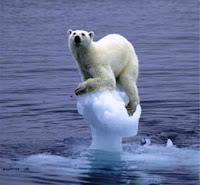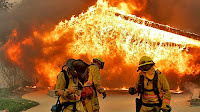 This week’s multiple days of frigid weather and snow flurries were quite the counterpoint to last week’s posting about Obama wrestling with global warming on his short list of big concerns. That’s the bummer about climate change—it makes weather patterns increasingly erratic, not predictably balmier.
This week’s multiple days of frigid weather and snow flurries were quite the counterpoint to last week’s posting about Obama wrestling with global warming on his short list of big concerns. That’s the bummer about climate change—it makes weather patterns increasingly erratic, not predictably balmier.And the fact that the weather may be changing doesn’t change the fact that we’ll still have snow.
But with snow falling and Thanksgiving arriving, thoughts do naturally turn to colder places, like the North Pole, habitat for reindeer, polar bears, and, of course, Santa and his elves. And the story there is interesting.
Classroom globes show a static amount of ice covering the Arctic Ocean above Canada and Russia. The truth is very different: the polar ice cap is a dynamic system that contracts and expands, thickens and thins with the seasons. During our summer, the ocean melts; in the winter, snow cover increases substantially. For millennia, permanent ice—ice that survives the summer thaw—outlasts the summer season and builds up, thick and massive deep-blue plateaus decades, even centuries old.
That was then.
For the last 30 years, polar scientists have been noting a decline is polar sea ice. In 2007, Arctic sea ice hit a record low, covering only 1.6 million square miles of ocean. The previous record? 2005. With the ice cap now rapidly cooling again, the National Snow and Ice Data Center says the ice covered 1.7 million square miles at its lowest point on September 12. To put this in perspective, 30 years ago there would be about 2.5 million square miles of ice left at the end of an Arctic summer—roughly the size of the lower 48 states. That's now dropped by almost 40 percent.
"We've essentially lost sea ice equivalent to land east of the Mississippi River and even beyond. So that's a significant amount of area," Walt Meier, a scientist at the snow center, recently told the BBC.
And here’s the kicker: both last summer and this one, for the first time in quite a while, the ice pulled far enough back from adjoining land masses that at high summer, a boat could circumnavigate the North Pole, using the northwest passage above Canada and the northeast passage above Siberia, to circle the globe in the north, in the Arctic Ocean.
So I’m happy to report that this summer's ice cover did not set a record. No. It was only was the second lowest since satellite records began 30 years ago, which Mier says emphasizes the “strong negative trend,” as the three years of the least amount of ice ever recorded all occurred within the last four years.
And the ice is younger: less of it is surviving the winter as permaice. And it is thinner—19% thinner last winter than the average of the previous five years. That’s a big change in one winter.
The best known consequence of disappearing sea ice has been the loss of polar bear habitat, an
 d the polar bear is quickly emerging as the poster child of global climate change. Dependent on sea ice for so much of its behavior, including standing on it to hunt for seals, its most important source of food, reports are emerging of bears starving, drowning, even eating each other. One scientist monitored 9 polar bears swimming in the Chukchi Sea north of the Bering Strait, not in itself unusual—bears are powerful swimmers capable of covering 100 miles in the water. The group was only 40 miles from land—but heading in the wrong direction, where the closest land was 400 miles away, well out of range.
d the polar bear is quickly emerging as the poster child of global climate change. Dependent on sea ice for so much of its behavior, including standing on it to hunt for seals, its most important source of food, reports are emerging of bears starving, drowning, even eating each other. One scientist monitored 9 polar bears swimming in the Chukchi Sea north of the Bering Strait, not in itself unusual—bears are powerful swimmers capable of covering 100 miles in the water. The group was only 40 miles from land—but heading in the wrong direction, where the closest land was 400 miles away, well out of range.In May, the polar bear was listed as threatened—one step away from endangered.
The scariest part of the data is the quickening pace of the change. Only a few years ago, many scientists were noticing a warning trend, and began predicting a totally ice-free Arctic Ocean at its summer peak within 50 or 80 years. Then they began saying it would likely happen within 30 years.
Some are now predicting only five years from now. Within five years, an ice-free pole in the summer.
For ice is a giant mirror reflecting sunlight back into space, protecting the ocean water below from sunlight energy. When sea ice melts, the sunlight strikes the dark ocean water, which then warms. As it warms, it melts more snow, which uncovers more water, which warms—and you have a positive feedback loop exacerbating the trend.
Now some nations, most notably Russia, are salivating over the notion of an ice-free Arctic, as there are huge possible pockets of oil trapped beneath the waters, oil much easier to reach without permanent ice. Talk about a positive feedback loop: the burning of fossil fuels releases carbon dioxide, which warms the climate, which melts the ice, which opens up new oil fields, which releases carbon dioxide—and ripples throughout both economy and ecology.
But all this discussion of polar bears and petro-exploitation misses the biggest issue raised by the possible melting of the Arctic’s ice cap:
Just where will Santa put his workshop as the sea ice vanishes beneath the North Pole?
Something to think about as you place your child atop Santa’s lap in the holiday season. And shop for presents that release no greenhouse gases.


 Obama
Obama 


